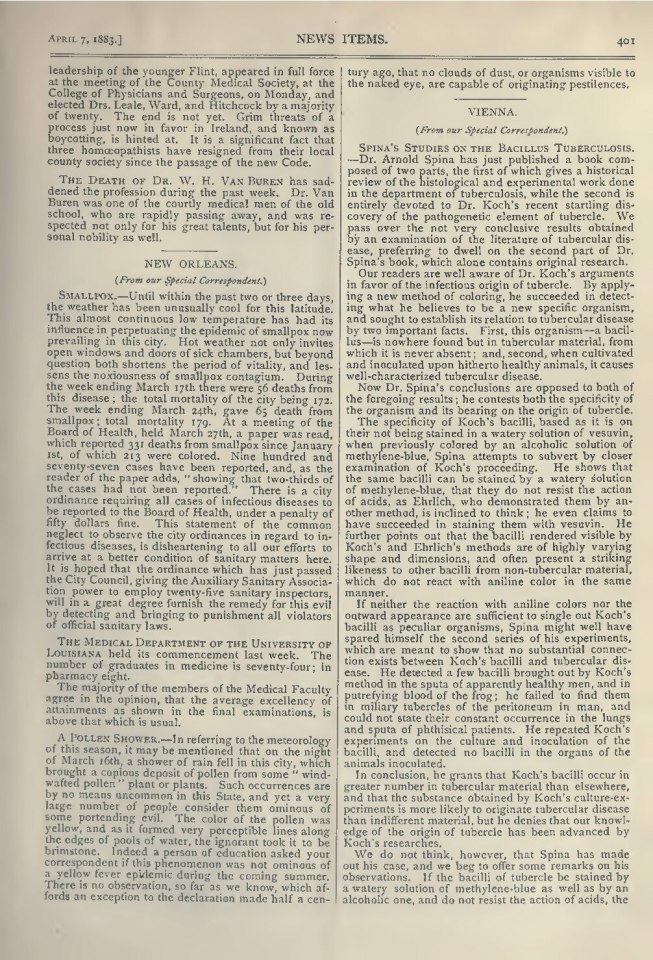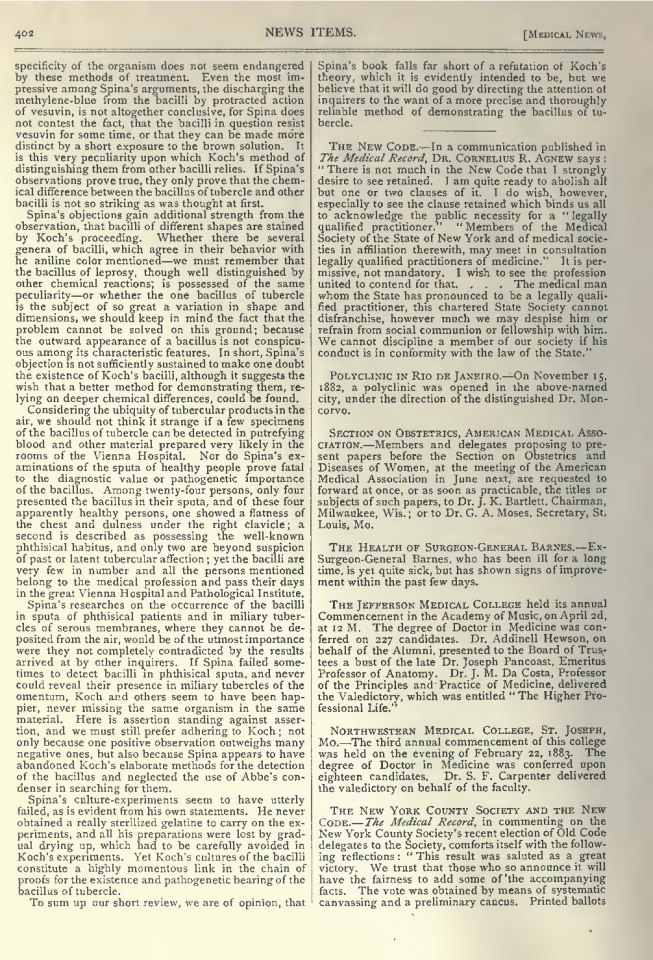S.
401
VIENNA.
(From our Special Correspondent.)
Spina’s Studies on The Bacillus Tuberculosis. – Dr. Arnold Spina has
just published a book composed of two parts, the first of which gives a historical
review of the histological and experimental work done in the department
of tuberculosis, while the second is entirely devoted to Dr. Koch’s recent
startling discovery of the pathogenetic element of tubercle. We pass over the
not very conclusive results obtained by an examination of the literature of
tubercular disease, preferring to dwell on the second part of Dr. Spina’s book,
which alone contains original research.Our readers are well aware of Dr. Koch’s arguments in favor of the infectious
origin of tubercle. By applying a new method of coloring, he succeeded
in detecting what he believes to be a new specific organism, and sought to
establish its relation to tubercular disease by two important facts. First, this
organism – a bacillus – is nowhere found but in tubercular material, from
which it is never absent; and, second, when cultivated and inoculated upon
hitherto healthy animals, it causes well-characterized tubercular disease.Now Dr. Spina’s conclusions are opposed to both of the foregoing results;
he contests both the specificity of the organism and its bearing on the origin
of tubercle.The specificity of Koch’s bacilli, based as it is on their not being stained in
a watery solution of vesuvin, when previously colored by an alcoholic solution
of methylene-blue, Spina attempts to subvert by closer examination of
Koch’s proceeding. He shows that the same bacilli can be stained by a watery
solution of methylene-blue, that they do not resist the action of acids, as
Ehrlich, who demonstrated them by another method, is inclined to think;
he even claims to have succeeded in staining them with vesuvin. He further
points out that the bacilli rendered visible by Koch’s and Ehrlich’s methods
are of highly varying shape and dimensions, and often present a striking
likeness to other bacilli from non-tubercular material, which do not react
with aniline color in the same manner.If neither the reaction with aniline colors nor the outward appearance are
sufficient to single out Koch’s bacilli as peculiar organisms, Spina might well
have spared himself the second series of his experiments, which are meant
to show that no substantial connection exists between Koch’s bacilli and tubercular
disease. He detected a few bacilli brought out by Koch’s method in
the sputa of apparently healthy men, and in putrefying blood of the frog;
he failed to find them in miliary tubercles of the peritoneum in man, and
could not state their constant occurrence in the lungs and sputa of phthisical
patients. He repeated Koch’s experiments on the culture and inoculation of
the bacilli, and detected no bacilli in the organs of the animals inoculated.In conclusion, he grants that Koch’s bacilli occur in greater number in
tubercular material than elsewhere, and that the substance obtained by Koch’s
culture-experiments is more likely to originate tubercular disease than indifferent
material, but he denies that our knowledge of the origin of tubercle
has been advanced by Koch’s researches.We do not think, however, that Spina has made out his case, and we beg to
offer some remarks on his observations. If the bacilli of tubercle be stained
by a watery solution of methylene-blue as well as by an alcoholic one, and do
not resist the action of acids, theS.
402
specificity of the organism does not
seem endangered by these methods of treatment. Even the most impressive
among Spina’s arguments, the discharging the methylene-blue from the bacilli
by protracted action of vesuvin, is not altogether conclusive, for Spina
does not contest the fact, that the bacilli in question resist vesuvin for some
time, or that they can be made more distinct by a short exposure to the brown
solution. It is this very peculiarity upon which Koch’s method of distinguishing
them from other bacilli relies. If Spina’s observations prove true, they
only prove that the chemical difference between the bacillus of tubercle and
other bacilli is not so striking as was thought at first.Spina’s objections gain additional strength from the observation, that bacilli
of different shapes are stained by Koch’s proceeding. Whether there be
several genera of bacilli, which agree in their behavior with the aniline color
mentioned – we must remember that the bacillus of leprosy, though well
distinguished by other chemical reactions; is possessed of the same peculiarity
– or whether the one bacillus of tubercle is the subject of so great a
variation in shape and dimensions, we should keep in mind the fact that the
problem cannot be solved on this ground; because the outward appearance
of a bacillus is not conspicuous among its characteristic features. In short,
Spina’s objection is not sufficiently sustained to make one doubt the existence
of Koch’s bacilli, although it suggests the wish that a better method for
demonstrating them, relying on deeper chemical differences, could be found.Considering the ubiquity of tubercular products in the air, we should not
think it strange if a few specimens of the bacillus of tubercle can be detected
in putrefying blood and other material prepared very likely in the rooms of
the Vienna Hospital. Nor do Spina’s examinations of the sputa of healthy
people prove fatal to the diagnostic value or pathogenetic importance of the
bacillus. Among twenty-four persons, only four presented the bacillus in
their sputa, and of these four apparently healthy persons, one showed a flatness
of the chest and dulness under the right clavicle; a second is described
as possessing the well-known phthisical habitus, and only two are beyond
suspicion of past or latent tubercular affection; yet the bacilli are very few
in number and all the persons mentioned belong to the medical profession
and pass their days in the great Vienna Hospital and Pathological Institute.Spina’s researches on the occurrence of the bacilli in sputa of phthisical
patients and in miliary tubercles of serous membranes, where they cannot
be deposited from the air, would be of the utmost importance were they not
completely contradicted by the results arrived at by other inquirers. If Spina
failed sometimes to detect bacilli in phthisical sputa, and never could reveal
their presence in miliary tubercles of the omentum, Koch and others seem
to have been happier, never missing the same organism in the same material.
Here is assertion standing against assertion, and we must still prefer adhering
to Koch; not only because one positive observation outweighs many negative
ones, but also because Spina appears to have abandoned Koch’s elaborate
methods for the detection of the bacillus and neglected the use of Abbe’s
condenser in searching for them.Spina’s culture-experiments seem to have utterly failed, as is evident from
his own statements. He never obtained a really sterilized gelatine to carry
on the experiments, and all his preparations were lost by gradual drying up,
which had to be carefully avoided in Koch’s experiments. Yet Koch’s cultures
of the bacilli constitute a highly momentous link in the chain of proofs for
the existence and pathogenetic bearing of the bacillus of tubercle.To sum up our short review, we are of opinion, that Spina’s book falls far
short of a refutation of Koch’s theory, which it is evidently intended to be,
but we believe that it will do good by directing the attention of inquirers to
the want of a more precise and thoroughly reliable method of demonstrating
the bacillus of tubercle.
401
–402


